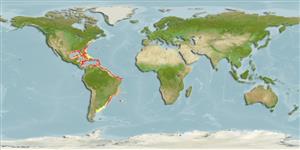>
Ophidiiformes (Cusk eels) >
Ophidiidae (Cusk-eels) > Neobythitinae
Etymology: Monomitopus: Greek, monos = one + Greek, mitos, -ou = sting of a lyre + Greek, pous = foot (Ref. 45335).
More on authors: Goode & Bean.
Environment: milieu / climate zone / depth range / distribution range
Ecologia
marino benthopelagico; distribuzione batimetrica 48 - 1125 m (Ref. 37039). Deep-water
Western Central Atlantic: Gulf of Mexico and Caribbean Sea.
Size / Peso / Age
Maturity: Lm ? range ? - ? cm
Max length : 20.3 cm SL maschio/sesso non determinato; (Ref. 75877)
Short description
Morfologia | Morfometria
Spine dorsali (totale): 0; Raggi dorsali molli (totale): 99-107; Spine anali 0; Raggi anali molli: 84 - 87. Upper jaw extending beyond hind margin of eye; preopercle with three spines along hind margin, inferior two spines stronger; scales small, deciduous; head wholly covered with scales except for lips and branchiostegal membrane (Ref. 13608).
Common species (Ref. 34024). Oviparous, with oval pelagic eggs floating in a gelatinous mass (Ref. 205).
Life cycle and mating behavior
Maturità | Riproduzione | Deposizione | Uova | Fecundity | Larve
Nielsen, J.G., D.M. Cohen, D.F. Markle and C.R. Robins, 1999. Ophidiiform fishes of the world (Order Ophidiiformes). An annotated and illustrated catalogue of pearlfishes, cusk-eels, brotulas and other ophidiiform fishes known to date. FAO Fish. Synop. 125(18):178p. Rome: FAO. (Ref. 34024)
IUCN Red List Status (Ref. 130435)
Threat to humans
Harmless
Human uses
Pesca: di nessun interesse
Informazioni ulteriori
Age/SizeAccrescimentoLength-weightLength-lengthLength-frequenciesMorfometriaMorfologiaLarveDinamica popolazioni larvaliReclutamentoAbbondanzaBRUVS
BibliografiaAcquacolturaProfilo di acquacolturaVarietàGeneticaElectrophoresesEreditarietàMalattieElaborazioneNutrientsMass conversion
CollaboratoriImmaginiStamps, Coins Misc.SuoniCiguateraVelocitàModalità di nuotoArea branchialeOtolithsCervelliVista
Strumenti
Special reports
Download XML
Fonti Internet
Estimates based on models
Preferred temperature (Ref.
123201): 8.7 - 19.6, mean 13.7 °C (based on 202 cells).
Phylogenetic diversity index (Ref.
82804): PD
50 = 0.5001 [Uniqueness, from 0.5 = low to 2.0 = high].
Bayesian length-weight: a=0.00380 (0.00165 - 0.00876), b=3.14 (2.93 - 3.35), in cm total length, based on LWR estimates for this (Sub)family-body shape (Ref.
93245).
Trophic level (Ref.
69278): 3.5 ±0.6 se; based on size and trophs of closest relatives
Resilienza (Ref.
120179): Alto, tempo minimo di raddoppiamento della popolazione meno di 15 mesi (Preliminary K or Fecundity.).
Fishing Vulnerability (Ref.
59153): Low vulnerability (15 of 100).
